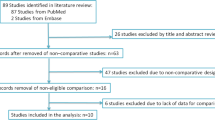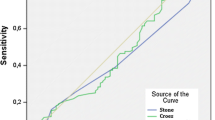Abstract
Purpose
To evaluate and compare the accuracy of S.T.O.N.E, Clinical Research Office of the Endourological Society (CROES), and Guy’s stone score in patients with chronic kidney disease (CKD) following percutaneous nephrolithotomy (PNL).
Methods
The charts of patients who had undergone a prone percutaneous nephrolithotomy from June 2006 to June 2016 were retrospectively analyzed. Patients accepted as stage 3 and higher according to chronic kidney disease epidemiology collaboration formula, were enrolled into the study. Calculation of the CROES, S.T.O.N.E, and Guy’s scoring system (SS) was made as defined in original papers. Patients were categorized into four scores according to CROES, into nine scores according to S.T.O.N.E, and into four scores according to Guy’s SS.
Results
A total of 303 patients fulfilled the study inclusion criteria. The mean preoperative eGFR and creatinine levels were 47 mL/min and 1.55 mg/dL, respectively. In patients who were stone free and those with residual stones, the mean CROES SS was 179 and 137 (p < 0.001), the mean S.T.O.N.E score was 8.8 and 9.9 (p < 0.001), and the mean Guy’s SS was 1.8 and 2.4 (p < 0.001), respectively. Multivariate regression analysis revealed CROES SS was the only scoring system, which had a predictive value for PNL outcome in patients with CKD (p = 0.011) and any of three SS were not useful for predicting PNL complications in patients with CKD.
Conclusion
Our study demonstrated the CROES SS was the only independent factor in the prediction of PNL outcome in CKD patients. Furthermore, three of the NSSs were not useful for predicting PNL complications in patients with CKD.


Similar content being viewed by others
References
Türk C, Knoll T, Petrik A et al (2015) European association of urology, guidelines on urolithiasis. Eur Urol 69:468
Kuzgunbay B, Turunc T, Yaycioglu O et al (2011) Percutaneous nephrolithotomy for staghorn kidney stones in elderly patients. Int Urol Nephrol 43:639–643
Levey AS, Coresh J, Balk E et al (2003) National Kidney Foundation practice guidelines for chronic kidney disease: evaluation, classification, and stratification. Ann Intern Med 139:137–147
Fox CS, Matsushita K, Woodward M et al (2012) Associations of kidney disease measures with mortality and end-stage renal disease in individuals with and without diabetes: a meta-analysis. Lancet 380:1662–1673
Smith A, Averch TD, Shahrour K et al (2013) A nephrolithometric nomogram to predict treatment success of percutaneous nephrolithotomy. J Urol 190:149–156
Okhunov Z, Friedlander JI, George AK et al (2013) STONE nephrolithometry: novel surgical classification system for kidney calculi. Urology 81:1154–1159
Thomas K, Smith NC, Hegarty N, Glass JM (2011) The Guy’s stone score—grading the complexity of percutaneous nephrolithotomy procedures. Urology 78:277–281
National Kidney Foundation (2013) Estimated glomerular filtration rate formula developed by Chronic Kidney Disease Epidemiology Collaboration (CKD-EPI). http://www.kidney.org/professionals/kdoqi/gfr_calculator. Accessed 7 Nov 2013
Dindo D, Demartines N, Clavien PA (2004) Classification of surgical complications: a new proposal with evaluation in a cohort of 6336 patients and results of a survey. Ann Surg 240:205–213
Jungers P, Joly D, Barbey F, Choukroun G, Daudon M (2004) ESRD caused by nephrolithiasis: prevalence, mechanisms, and prevention. Am J Kidney Dis 44:799–805
Gupta M, Bolton DM, Gupta PN, Stoller ML (1994) Improved renal function following aggressive treatment of urolithiasis and concurrent mild to moderate renal insufficiency. J Urol 152:1086–1090
Lukaszyk E, Lukaszyk M, Koc-Zorawska E, Bodzenta-Lukaszyk A, Malyszko J (2016) GDF-15, iron, and inflammation in early chronic kidney disease among elderly patients. Int Urol Nephrol 48:839–844
Cader RA, Ibrahim OA, Paul S, Gafor HA, Mohd R (2014) Left ventricular hypertrophy and chronic fluid overload in peritoneal dialysis patients. Int Urol Nephrol 46:1209–1215
Sfoungaristos S, Gofrit ON, Yutkin V, Landau EH, Pode D, Duvdevani M (2016) External validation of CROES nephrolithometry as a preoperative predictive system for percutaneous nephrolithotomy outcomes. J Urol 195:372–376
Akhavein A, Henriksen C, Syed J, Bird VG (2015) Prediction of single procedure success rate using S.T.O.N.E nephrolithometry surgical classification system with strict criteria for surgical outcome. Urology 85:69–73
Mandal S, Goel A, Kathpalia R et al (2012) Prospective evaluation of complications using the modified Clavien grading system, and of success rates of percutaneous nephrolithotomy using Guy’s Stone Score: a single-center experience. Indian J Urol 28:392–398
Labadie K, Okhunov Z, Akhavein A et al (2015) Evaluation and comparison of urolithiasis scoring systems used in percutaneous kidney stone surgery. J Urol 193:154–159
Tailly TO, Okhunov Z, Nadeau BR et al (2016) Multicenter external validation and comparison of stone scoring systems in predicting outcomes after percutaneous nephrolithotomy. J Endourol 30:594–601
Sfoungaristos S, Gofrit ON, Pode D, Landau EH, Duvdevani M (2016) Percutaneous nephrolithotomy for staghorn stones: which nomogram can better predict postoperative outcomes? World J Urol 34:1163–1168
Choi SW, Bae WJ, Ha US et al (2017) Prediction of stone-free status and complication rates after tubeless percutaneous nephrolithotomy: a comparative and retrospective study using three stone-scoring systems and preoperative parameters. World J Urol 35:449–457
Yarimoglu S, Polat S, Bozkurt IH et al (2016) Comparison of S.T.O.N.E and CROES nephrolithometry scoring systems for predicting stone-free status and complication rates after percutaneous nephrolithotomy: a single center study with 262 cases. Urolithiasis. doi:10.1007/s00240-016-0935-0
Kumar S, Sreenivas J, Karthikeyan VS, Mallya A, Keshavamurthy R (2016) Evaluation of CROES nephrolithometry nomogram as a preoperative predictive system for percutaneous nephrolithotomy outcomes. J Endourol 30:1079–1083
Author information
Authors and Affiliations
Corresponding author
Ethics declarations
Conflict of interest
The authors declare that they have no conflict of interest.
Informed consent
Informed consent was obtained from all individual participants included in the study.
Ethical standards
All procedures performed in studies involving human participants were in accordance with the ethical standards of the institutional and/or national research committee and with the 1964 Declaration of Helsinki and its later amendments or comparable ethical standards.
Rights and permissions
About this article
Cite this article
Yanaral, F., Ozgor, F., Savun, M. et al. Comparison of CROES, S.T.O.N.E, and Guy’s scoring systems for the prediction of stone-free status and complication rates following percutaneous nephrolithotomy in patients with chronic kidney disease. Int Urol Nephrol 49, 1569–1575 (2017). https://doi.org/10.1007/s11255-017-1631-x
Received:
Accepted:
Published:
Issue Date:
DOI: https://doi.org/10.1007/s11255-017-1631-x




